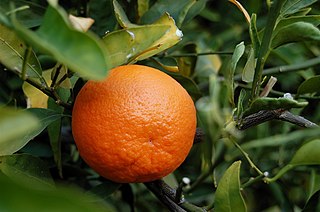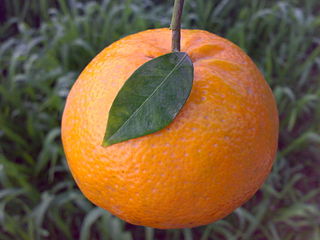Related Research Articles

Citrus is a genus of flowering trees and shrubs in the rue family, Rutaceae. Plants in the genus produce citrus fruits, including crops such as oranges, mandarins, lemons, grapefruits, pomelos, and limes. The genus Citrus is native to South Asia, East Asia, Southeast Asia, Melanesia, and Australia. Various citrus species have been used and domesticated by indigenous cultures in these areas since ancient times. From there its cultivation spread into Micronesia and Polynesia by the Austronesian expansion ; and to the Middle East and the Mediterranean via the incense trade route, and onwards to Europe and the Americas.

A clementine is a tangor, a citrus fruit hybrid between a willowleaf mandarin orange and a sweet orange, named in honor of Clément Rodier, a French missionary who first discovered and propagated the cultivar in Algeria. The exterior is a deep orange colour with a smooth, glossy appearance. Clementines can be separated into 7 to 14 segments. Similar to tangerines, they tend to be easy to peel. They are typically juicy and sweet, with less acid than oranges. Their oils, like other citrus fruits, contain mostly limonene as well as myrcene, linalool, α-pinene and many complex aromatics.

The mandarin orange, also known as mandarin or mandarine, is a small, rounded citrus tree fruit. Treated as a distinct species of orange, it is usually eaten plain or in fruit salads. Tangerines are a group of orange-colored citrus fruit consisting of hybrids of mandarin orange with some pomelo contribution.

The tangerine is a type of citrus fruit that is orange in color, that is considered either a variety of Citrus reticulata, the mandarin orange, or a closely related species, under the name Citrus tangerina, or yet as a hybrid of mandarin orange varieties, with some pomelo contribution.

The tangelo, Citrus × tangelo, is a citrus fruit hybrid of a Citrus reticulata variety, such as mandarin orange or tangerine, and a Citrus maxima variety, such as a pomelo or grapefruit. The name is a portmanteau of 'tangerine' and 'pomelo'.

The pomelo, from the family Rutaceae, is the largest citrus fruit, and the principal ancestor of the grapefruit. It is a natural, non-hybrid, citrus fruit, native to Southeast Asia. Similar in taste to a sweet grapefruit, the pomelo is commonly consumed and used for festive occasions throughout Southeast Asia and East Asia. As with the grapefruit, phytochemicals in the pomelo have the potential for drug interactions.

The tangor is a citrus fruit hybrid of the mandarin orange and the sweet orange. The name "tangor" is a formation from the "tang" of tangerine and the "or" of "orange." Also called the temple orange, its thick rind is easy to peel and its bright orange pulp is sour-sweet and full-flavoured.

An oroblanco, oro blanco, or sweetie (Israel) is a sweet seedless citrus hybrid fruit similar to grapefruit. It is often referred to as oroblanco grapefruit.

The ponderosa lemon is a citrus hybrid of a pomelo and a citron. It is not the same as the 'Yuma Ponderosa' lemon-pomelo hybrid used as citrus rootstock.

The Kinnow is a high yield mandarin hybrid cultivated extensively in the wider Punjab region of India and Pakistan.
The University of California Citrus Experiment Station is the founding unit of the University of California, Riverside campus in Riverside, California, United States. The station contributed greatly to the cultivation of the orange and the overall agriculture industry in California. Established February 14, 1907, the station celebrated its 100th anniversary in 2007.

Cam sành or King orange is a citrus hybrid originating in Vietnam.
Robert K. Soost was a citrus expert and professor of genetics at University of California, Riverside, and sixth curator of the University of California Citrus Variety Collection.

The kishu mikan is a hybrid variety of mikan, or mandarin orange, found in Southern China and also grown in Japan.

Setoka is a seedless and highly sweet Japanese citrus fruit that is a tangor, a hybrid of the Murcott tangor with "Kuchinotsu No.37", which in turn is a hybrid of the Kiyomi tangor and a King tangor/Willowleaf mandarin cross, "Encore No. 2". It was registered as "Tangor Nōrin No.8" in 1998 and as "Variety registration No.9398" under the Plant Variety Protection and Seed Act in 2001. It weighs 200–280 g (7.1–9.9 oz) and has an oblate shape. The rind is thin and easily peelable. Its flavor is pleasant, aromatic, and similar to the Murcott. The fruit ripens in February. Its sugar level is very high at 12–13 °Bx whereas its citric acid is low (0.8–1.0%).
The Citrus Industry is a book consisting of five volumes of scientific and experimental information on all the citrus species and varieties, originals as well as hybrids.
James W. Cameron was an emeritus professor of horticultural science, a geneticist and citrus breeder in the University of California Citrus Experiment Station.

The Melogold or Melogold grapefruit is a citrus hybrid similar to the oroblanco; both result from a cross between the pomelo and the grapefruit and is a fruit similar to a sweet grapefruit.

The Murcott is a tangor, or mandarin–sweet orange hybrid.
The Dancy tangerine is one of the oldest and formerly most popular American citrus varieties, but is now rarely sold.
References
- ↑ "Pixie Tangerine of Ojai Valley". Ark of Taste. Slow Food USA. Archived from the original on 5 September 2015.
- 1 2 "Pixie mandarin Citrus reticulata Blanco". University of California Riverside Citrus Variety Collection. Retrieved 31 December 2020.
- ↑ Karp, David (1 April 2011). "Market Watch: Pixie mandarins are a farmers market favorite". Los Angeles Times. Retrieved 31 December 2020.